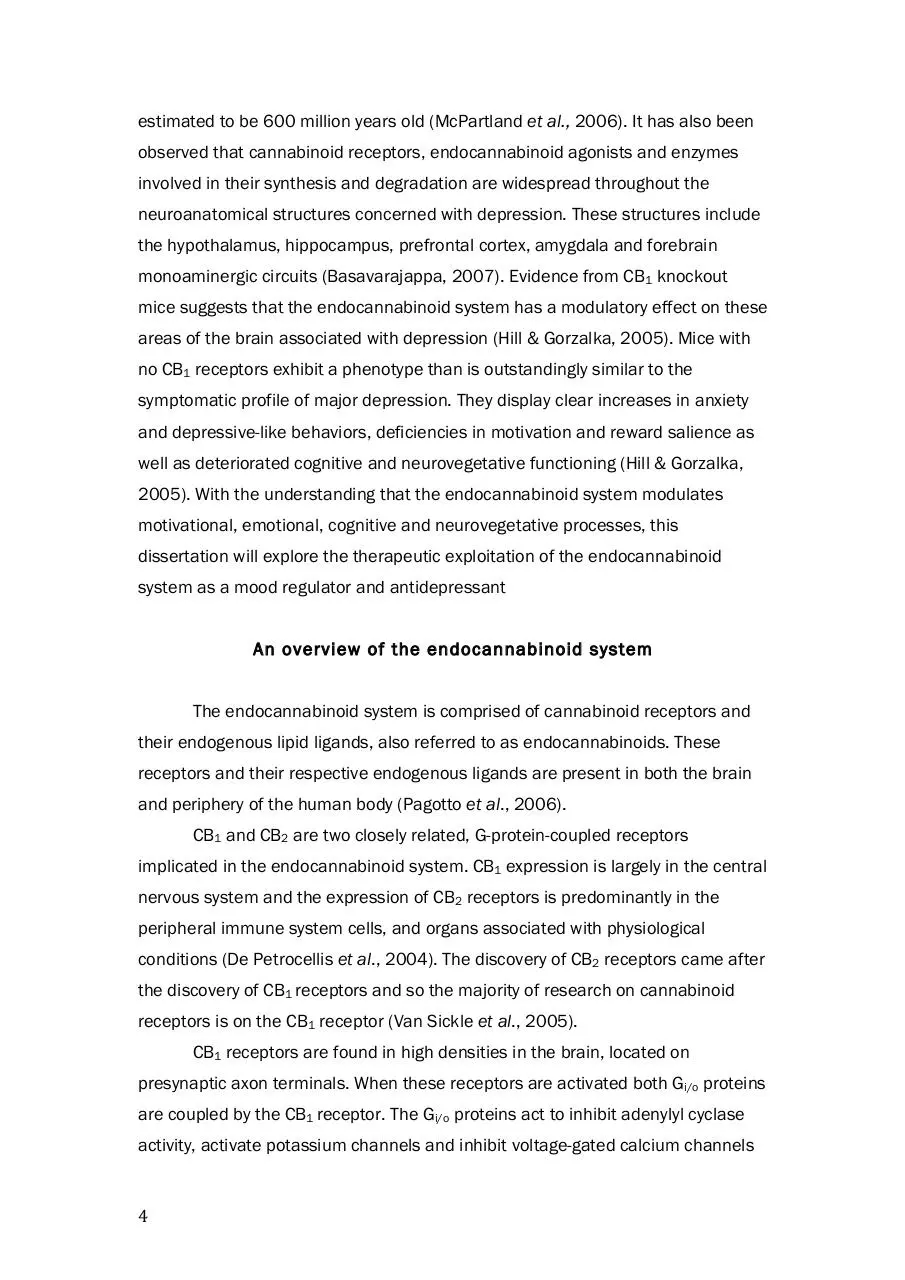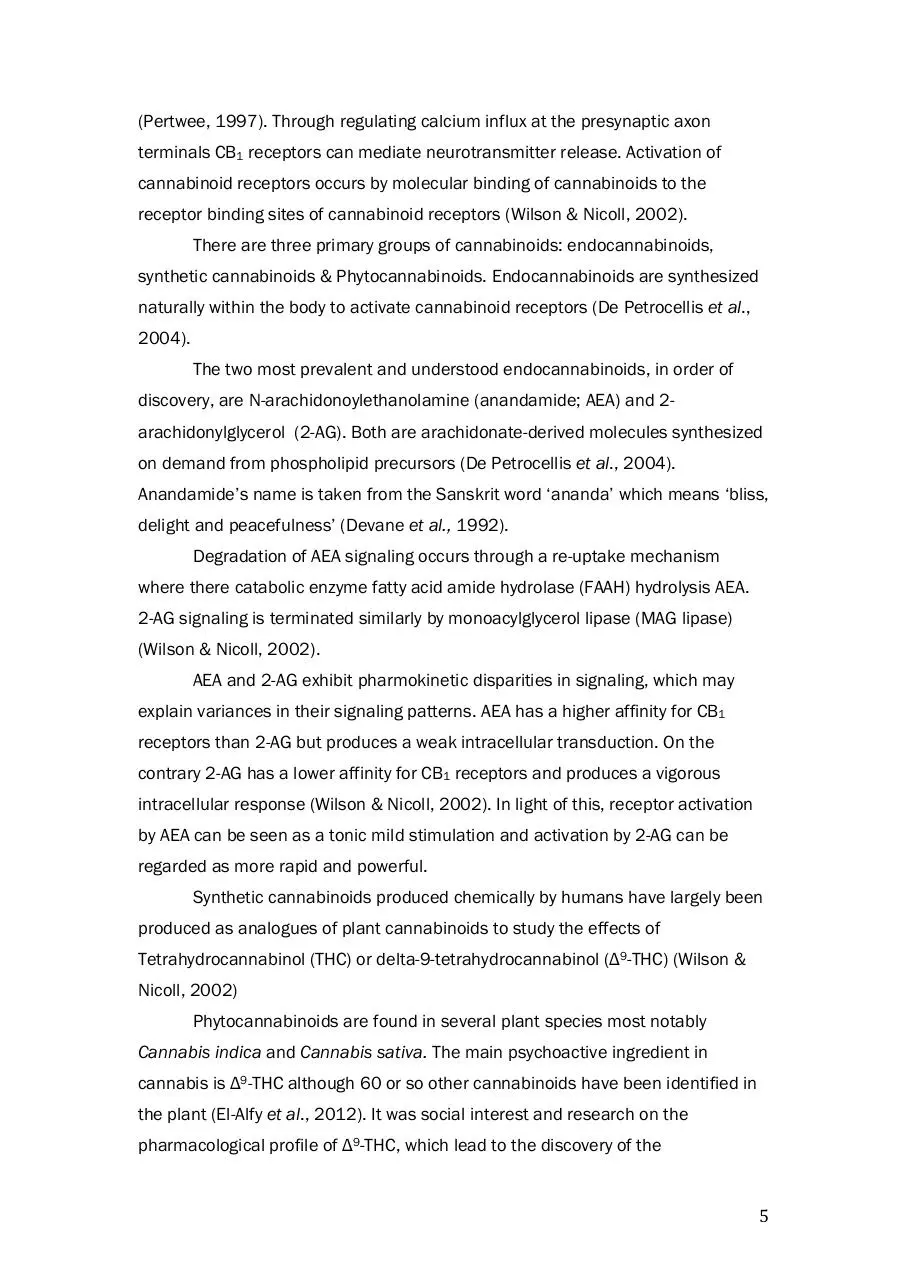Cannabinoids as medicine (PDF)
File information
Title: Microsoft Word - Dissertation revised copy..docx
Author: Ross
This PDF 1.3 document has been generated by Word / Mac OS X 10.7.5 Quartz PDFContext, and has been sent on pdf-archive.com on 14/09/2016 at 17:10, from IP address 2.27.x.x.
The current document download page has been viewed 391 times.
File size: 163.06 KB (25 pages).
Privacy: public file





File preview
Exploitation of the endocannabinoid system in the
treatment of depression
Student: Ross Shirish
Supervisor: Mikhail Soloviev
Contents
Summary…………………………………………………………………………………………………………3
Introduction………………………………………………………………………………………..……………3
An overview of the endocannabinoid system……………………………………………………..4
Pathophysiology of major depressive disorder…………………………………………………..6
Efficacy and limitations with the current treatments of major depressive
disorder ………………………………………………………………………………………...……………….7
Pharmalogical methods of manipulating the endocannabinoid system for treating
depression………………………………………………………………………………………………………9
Augmentation of the endocannabinoid system increases monoaminergic
neurotransmission…………………………………………………………………………………………11
Manipulation of the endocannabinoid system regulates neurovegetative
symptoms of depression………………………………………………………………………………..12
Augmentation of the endocannabinoid system reduces stress, a causative factor
of depression………………………..……………………………………………………………………….14
Enhancement of the endocannabinoid system promotes neurogenesis in the
hippocampus…………………………………………………………………………………………………16
The endocannabinoid system controls the extinction of aversive memories……..17
Conclusions…………………………………………………………………………………………………..18
References……………………………………………………………………………………………..…….18
2
Exploitation of the endocannabinoid system in the treatment of
depression
Summary
Major depressive disorder is one of the most common mental health illness’
affecting over 350 million people globally. 30% of patients do not respond to
current treatments and many patients experience a wide range of side effects
from pharmacological treatments. The endocannabinoid system is
neuromodulatory system attributed with all of the neuroanatomical structures
associated with depression. Cannabinoid receptors (CB1 and CB2) are activated by
cannabinoid agonists, which augment endocannabinoid signalling. Augmentation
of the endocannabinoid system has been found to exhibit antidepressant and
anxiogenic effects. Enhancement of the endocannabinoid system can be
produced through the use of cannabinoid receptor agonists or the inhibition of
endocannabinoid catabolic processes. Through such measures augmentation of
the endocannabinoid system increases the monoaminergic neurotransmission,
reduces stress and anxiety, promotes neurogenesis in the hippocampus, controls
the extinction of aversive memories and alleviates the neurovegetative symptoms
associated with depression.
Introduction
The concept of the endocannabinoid system playing a role in mood
regulation comes from the fact that the exploitation of Cannabis sativa’s mood
elevating properties has been on going for centuries across the world (Williamson
& Evans, 2000). Since the discovery of the endocannabinoid system in the early
1990’s a wealth of research has revealed that it is a profound neuromodulatory
system with important roles in maintaining physical and emotional homeostasis
(Pagotto et al., 2006). Despite its recent discovery the endocannabinoid system
has been preserved throughout the evolutionary history of all vertebrates and is
3
estimated to be 600 million years old (McPartland et al., 2006). It has also been
observed that cannabinoid receptors, endocannabinoid agonists and enzymes
involved in their synthesis and degradation are widespread throughout the
neuroanatomical structures concerned with depression. These structures include
the hypothalamus, hippocampus, prefrontal cortex, amygdala and forebrain
monoaminergic circuits (Basavarajappa, 2007). Evidence from CB1 knockout
mice suggests that the endocannabinoid system has a modulatory effect on these
areas of the brain associated with depression (Hill & Gorzalka, 2005). Mice with
no CB1 receptors exhibit a phenotype than is outstandingly similar to the
symptomatic profile of major depression. They display clear increases in anxiety
and depressive-like behaviors, deficiencies in motivation and reward salience as
well as deteriorated cognitive and neurovegetative functioning (Hill & Gorzalka,
2005). With the understanding that the endocannabinoid system modulates
motivational, emotional, cognitive and neurovegetative processes, this
dissertation will explore the therapeutic exploitation of the endocannabinoid
system as a mood regulator and antidepressant
An overview of the endocannabinoid system
The endocannabinoid system is comprised of cannabinoid receptors and
their endogenous lipid ligands, also referred to as endocannabinoids. These
receptors and their respective endogenous ligands are present in both the brain
and periphery of the human body (Pagotto et al., 2006).
CB1 and CB2 are two closely related, G-protein-coupled receptors
implicated in the endocannabinoid system. CB1 expression is largely in the central
nervous system and the expression of CB2 receptors is predominantly in the
peripheral immune system cells, and organs associated with physiological
conditions (De Petrocellis et al., 2004). The discovery of CB2 receptors came after
the discovery of CB1 receptors and so the majority of research on cannabinoid
receptors is on the CB1 receptor (Van Sickle et al., 2005).
CB1 receptors are found in high densities in the brain, located on
presynaptic axon terminals. When these receptors are activated both Gi/o proteins
are coupled by the CB1 receptor. The Gi/o proteins act to inhibit adenylyl cyclase
activity, activate potassium channels and inhibit voltage-gated calcium channels
4
(Pertwee, 1997). Through regulating calcium influx at the presynaptic axon
terminals CB1 receptors can mediate neurotransmitter release. Activation of
cannabinoid receptors occurs by molecular binding of cannabinoids to the
receptor binding sites of cannabinoid receptors (Wilson & Nicoll, 2002).
There are three primary groups of cannabinoids: endocannabinoids,
synthetic cannabinoids & Phytocannabinoids. Endocannabinoids are synthesized
naturally within the body to activate cannabinoid receptors (De Petrocellis et al.,
2004).
The two most prevalent and understood endocannabinoids, in order of
discovery, are N-arachidonoylethanolamine (anandamide; AEA) and 2arachidonylglycerol (2-AG). Both are arachidonate-derived molecules synthesized
on demand from phospholipid precursors (De Petrocellis et al., 2004).
Anandamide’s name is taken from the Sanskrit word ‘ananda’ which means ‘bliss,
delight and peacefulness’ (Devane et al., 1992).
Degradation of AEA signaling occurs through a re-uptake mechanism
where there catabolic enzyme fatty acid amide hydrolase (FAAH) hydrolysis AEA.
2-AG signaling is terminated similarly by monoacylglycerol lipase (MAG lipase)
(Wilson & Nicoll, 2002).
AEA and 2-AG exhibit pharmokinetic disparities in signaling, which may
explain variances in their signaling patterns. AEA has a higher affinity for CB1
receptors than 2-AG but produces a weak intracellular transduction. On the
contrary 2-AG has a lower affinity for CB1 receptors and produces a vigorous
intracellular response (Wilson & Nicoll, 2002). In light of this, receptor activation
by AEA can be seen as a tonic mild stimulation and activation by 2-AG can be
regarded as more rapid and powerful.
Synthetic cannabinoids produced chemically by humans have largely been
produced as analogues of plant cannabinoids to study the effects of
Tetrahydrocannabinol (THC) or delta-9-tetrahydrocannabinol (Δ9-THC) (Wilson &
Nicoll, 2002)
Phytocannabinoids are found in several plant species most notably
Cannabis indica and Cannabis sativa. The main psychoactive ingredient in
cannabis is Δ9-THC although 60 or so other cannabinoids have been identified in
the plant (El-Alfy et al., 2012). It was social interest and research on the
pharmacological profile of Δ9-THC, which lead to the discovery of the
5
endocannabinoid system in the mammalian brain. Because Δ9-THC found in
cannabis is a CB1 receptor agonist, this suggests that increased CB1 signaling
stimulates positive mood and so likely employs antidepressant properties.
(Williamson & Evans, 2000)
Pathophysiology of major depressive disorder
Major depressive disorder is the most common form of depression and is one of
the most prevalent mental disorders in the world. Major depression is a disabling
mood disorder that can cause premature fatality in its worst phase (Belmaker &
Agam, 2008)
Symptoms of depression vary from mild to severe, encompassing both
psychological and physiological symptoms. Common psychological symptoms of
depression include feelings of anhedonia (the inability to experience pleasure),
intense sadness, fatigue, worthlessness and guilt (Belmaker & Agam, 2008).
Those affected also have a lack of interest and an inability to concentrate on most
tasks. More severe symptoms include thoughts of self-harm and suicide which
accounts for 1 million deaths worldwide every year of which >90% of victims were
depressed. The rate of suicide mortality has also seen a 60% increase in the last
45 years (WHO, 2012).
Physiological symptoms, which arise through depressions maladaptive
effect on neurovegetative processes, include insomnia, hypersomnia, weight loss,
weight gain and increased release of stress hormones. The elevated levels of
circulating stress hormones explain why anxiety is common feature of depression
(Belmaker & Agam, 2008). Because symptoms of depression are often
bidirectional, the illness often persists undiagnosed, increasing the diseases
burden to society.
A wealth of factors can contribute to the cause of depression including
genetics, hormonal imbalances, ill health and major life events both negative &
positive such as bereavement, unemployment, marriage, childbirth and divorce
(Caspi et al., 2003). More than 350 million people globally of all ages are affected
by depression with >20% of the world adult population experiencing major
depression or another mood disorder during their lifetime (Marcus et al., 2012).
WHO predict that by 2020 depression will be the second leading cause of
6
premature death and is currently the leading cause of disability across the world
(Marcus et al., 2012).
Efficacy and limitations with the current treatments for major
depressive disorder
It is well recognized that chemical imbalances of the monoamines
serotonin, norepinephrine and dopamine play significant roles in major
depression. Antidepressants aim to restore these imbalances, usually by
inhibiting their neuronal reuptake. These three monoamines can be targeted
individually or collectively, but most commonly reversal of the under activity of 5HT neurotransmission is a key therapeutic goal (Blier & Demontigny, 1994).
Pharmacotherapy is the most popular treatment for major depression with several
classes of antidepressants available (Table 1).
7
Antidepressant
Selective serotonin
reuptake inhibitors
(SSRIs)
Serotonin-norepinephrine
reuptake inhibitors
(SNRIs)
Tricyclic antidepressants
(TCAs)
Monoamine oxidase
inhibitors (MAOIs)
Atypical antidepressants
Efficacy
SSRIs are the most widely
prescribed antidepressants.
SSRIs increase serotonin
levels in the synaptic cleft by
preventing the reuptake of
serotonin, increasing
neurotransmitter binding to
the postsynaptic receptor
(Blier & Demontigny, 1994)
SNRIs act similarly to SSRIs
but also increase levels of the
neurotransmitter
norepinephrine by blocking its
reuptake (Hartford et al.,
2007).
TCAs work by inhibiting the
reuptake of serotonin,
norepinephrine and partially
dopamine. They are not
considered as a first line resort
due to a broader range of side
effects and so SSRIs and
SNRIs are usually prescribed
over TCAs (Blier & Demontigny,
1994).
MAOIs are the oldest class of
antidepressant, which act to
reduce the activity of
monoamine oxidase (MAO).
MAO facilities the removal of
norepinephrine, serotonin and
dopamine from the brain so
inhibition of this enzyme
increases their circulating
levels (Blier & Demontigny,
1994)
Atypical antidepressants don’t
fit into a particular class off
antidepressants as they have
unique efficacies. Although
each atypical antidepressant is
unique and so side affects
vary with each course, they
tend to have less side affects
than SSRIs SNRIs TCAs and
MAOIs, as they are the 2nd
generation of antidepressants
(Grady & Stahl, 2012)
Side-effects
Nausea
Insomnia
Anxiety
Sexual dysfunction
Weight gain
Difficulty urinating
Headaches
Fatigue
(Wilson & Mottram, 2004)
Nausea
Insomnia
Anxiety
Sexual dysfunction
Weight gain
Difficulty urinating
Headaches
Fatigue
(Wilson & Mottram, 2004)
Sexual dysfunction
Blurred vision
Increased cardiac output
Disorientation and
confusion
ü Sun sensitivity
ü Constipation
ü Nausea
ü Difficulty urinating
ü (Wilson & Mottram, 2004)
In the past they have been
used as a last line of
pharmacotherapy due to
potentially lethal dietary
interactions, however recent
research suggests that
concerns regarding their side
affects is misconstrued, with
side effects similar to SSRIs
(Grady & Stahl, 2012)
ü
ü
ü
ü
ü
ü
ü
ü
ü
ü
ü
ü
ü
ü
ü
ü
ü
ü
ü
ü
ü
ü
Side affects are the same as
those observed in SSRIs and
SNRIs with reduced severity
and incidence (Grady & Stahl,
2012)
Table 1. The efficacy and side-affects of the main pharmalogical treatments for major depressive disorder
There is an extensive range of pharmacological therapies available that
have been found to successfully restore chemical imbalances of serotonin,
norepinephrine and dopamine in the brain. Despite this approximately 30% of the
population do no respond to current therapies and pharmacotherapy often entails
8
a range of negative side affects (Table 1). With this in mind there is clear scope
for the exploration of novel therapeutic treatments for major depressive disorder
(Pacher & Kesckemeti, 2004).
Pharmalogical methods of manipulating the endocannabinoid system
for treating depression
Manipulation of the endocannabinoid system has provided an insight into the
relationship between the effects of endocannabinoid signalling in animals and
major depression. The biochemical machinery used to manipulate the
endocannabinoid system can be considered as proposed methods of treatment
for depression. There is a range of tools used to manipulate endocannabinoid
signalling, with varying efficacies and side affects.
A variety of synthetic cannabinoids, usually based on the chemical
structure of Δ9-THC have been created to augment endocannabinoid action.
Exogenous cannabinoids posses various affinities and efficacies as cannabinoid
receptor agonists, some having the same affinity for CB1 and CB2 receptors (Δ9THC), and others with affinities for only CB1 (e.g. ACEA) or CB2 (e.g. AM-1241)
receptors (Saito et al., 2010).
Using cannabinoid agonists to augment endocannabinoid action has
shown efficacy in alleviating symptoms of depression in animal studies. For
example low doses of Δ9-THC and other structurally similar cannabinoids exerted
anxiolytic effects in mice, impaired the formation of fear and aided the extinction
of fear (Saito et al., 2010). The administration of cannabinoid agonists through
Intracerebral microinjections in the brain regions associated with emotion
including the ventromedial prefrontal cortex, ventral hippocampus and the
basolateral amygdala also produced both antidepressant and anxiolytic
behaviours (Rubino et al., 2008). In forced swim tests mice also showed anxiolytic
and antidepressant behavioural responses under both acute and chronic doses of
cannabinoid agonists (Hill & Gorzalka, 2005).
There are several side-affects to consider however when using
cannabinoid agonists as a therapeutic treatment for depression. Variances in
dosage have been shown to produce conflicting effects with low doses producing
anxiolytic and antidepressant effects and higher doses shown to produce
anxiogenic and depressive effects (Long et al., 2010). Targeting cannabinoid
9
Download Cannabinoids as medicine
Cannabinoids as medicine.pdf (PDF, 163.06 KB)
Download PDF
Share this file on social networks
Link to this page
Permanent link
Use the permanent link to the download page to share your document on Facebook, Twitter, LinkedIn, or directly with a contact by e-Mail, Messenger, Whatsapp, Line..
Short link
Use the short link to share your document on Twitter or by text message (SMS)
HTML Code
Copy the following HTML code to share your document on a Website or Blog
QR Code to this page

This file has been shared publicly by a user of PDF Archive.
Document ID: 0000483244.